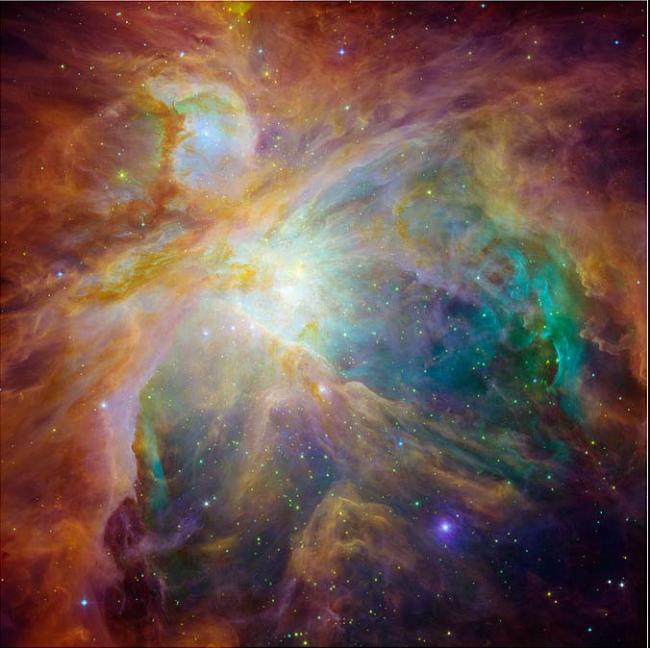
A false-color infrared image of the Orion Nebula and its cluster of young stars, taken by the IRAC instrument on the Spitzer Space Telescope.
Most stars form in clusters, sometimes with ten thousand or more stars packed into a volume smaller than a few light-years in radius. (By way of comparison, the nearest star to the sun is about four light years
away.) Astronomers know that stars form as gravity coalesces the gas and dust in an interstellar cloud until the material develops clumps dense enough to become stars. Exactly how this happens, however, is uncertain. In a cluster, where each natal environment is influenced by the births of neighboring stars, the situation is even more complex. As clusters age, their dimensions swell and the gravitational interactions of adjacent stars fling them apart. Eventually, as in the case of the sun, evidence of the early nursery disperses.
The closest, populous young stellar cluster to earth with some massive stars is the Orion Nebula Cluster (ONC). Previous studies have estimated the median age of its stars as one million years, young enough to retain information about the original condition of the gas and dust when the stars began to form, and hence making it a prime site for studying the initial conditions of star clusters. SAO astronomers Gabor Furesz and Andrew Szentgyorgyi, together with three of their colleagues, used the Hectochelle multiple-object spectrometer on the 6.5m MMT telescope in Arizona to study 1215 stars in the ONC. The spectra enabled the astronomers to estimate the ages and masses of the stars, as well as their motions.
Writing in last month's Astrophysical Journal, the team reports confirming in general the age estimates of the region, but they call attention to a serious discrepancy in the formal ages of intermediate-mass stars in the cluster, one that suggests this population is older than the other stars (and hence that somehow mid-sized stars were the first to form); they suggest accretion onto these stars could explain their appearing older than they are. The scientists also characterize the uniform rotation (or perhaps shear) motion of the stars in the ONC, find a filament of stars that may still be falling in towards the center of the cluster, and identify binary stars, stars with unusually high velocities (some of which could be run-aways), stars that are still accreting, stars with circumstellar disks, and not least, a set of stars that are probably not associated with the ONC at all but just happen to lie along our line-of-sight. The results significantly improve our understanding of the detailed structure of the ONC, and hence of young stellar clusters in general.